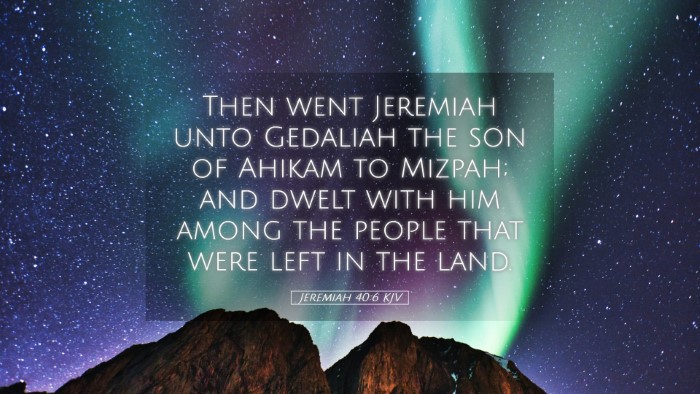Commentary on Jeremiah 40:6
Jeremiah 40:6 states:
"Then went Jeremiah unto Gedaliah the son of Ahikam to Mizpah; and dwelt with him among the people that were left in the land."
Contextual Overview
This verse occurs in a significant context following the destruction of Jerusalem and the Babylonian exile. As the remnant of Judah prepares to live amidst distressing changes, the figure of Gedaliah emerges as a central character who is appointed by the Babylonians to govern the remaining people.
Exegesis and Interpretation
Jeremiah's journey to Gedaliah is instructive for both understanding the prophet's role and the dynamics of leadership in post-exilic Judah. The verse encapsulates themes of hope, restoration, and divine sovereignty.
Jeremiah's Role
Matthew Henry offers valuable insights into Jeremiah's character, highlighting his steadfastness and willingness to minister to the remnant despite the considerable trials. His visit to Gedaliah illustrates the prophet's commitment to care for God's people even in times of despair. As a prophet, he provides guidance and comfort in uncertain circumstances:
- Pastoral Leadership: Jeremiah's support for Gedaliah signifies the importance of pastoral leadership in guiding a community faced with desolation.
- Prophetic Presence: His presence among the people symbolizes God's ongoing relationship and concern for His people, even when judgment was evident.
Gedaliah's Governance
Albert Barnes emphasizes Gedaliah's role as a governor appointed by the Babylonian ruler. His position is indicative of a new beginning for the remnant within a foreign rule. Gedaliah is seen as a stabilizing force, representing the possibility of rebuilding and re-establishing community life:
- Character of Gedaliah: Gedaliah’s character is portrayed as gentle and fair, seeking to comfort the people and encourage them to settle and cultivate the land that remains.
- Sign of Hope: The appointment by the Babylonians can be interpreted as a sign of mercy, providing a semblance of autonomy to the people of Judah even under foreign dominion.
Theological Implications
Adam Clarke delves into the theological implications of this passage, noting the sovereignty of God in the event of the Babylonian exile. He highlights that God's plans continue unfolding, despite the tragic circumstances that beset Jerusalem. Key theological insights include:
- Divine Sovereignty: God retains control over nations and events; He directs the movements of leaders like Gedaliah for the ultimate purpose of restoring His people.
- Restoration and Renewal: The arrival of Jeremiah among the remnants illustrates God's intent to restore His people, emphasizing themes of hope amid judgment.
Pastoral Reflections
This verse has profound implications for pastoral ministry today. In the midst of societal upheaval and difficulties, the call remains for ministers to embody the compassionate presence of God by:
- Engaging in Community: Just as Jeremiah engaged with the people left in the land, pastors are encouraged to immerse themselves in their congregations and communities, offering support and guidance.
- Promoting Hope: The ministry should aim at fostering hope and restoration, especially during challenging times, conveying that God’s plans are still in effect.
Application for Theologians and Scholars
Theologically, Jeremiah 40:6 invites scholars to consider the broader narrative of Scripture as it pertains to God's people. Key points for consideration include:
- Covenantal Faithfulness: Scholars must reflect on how God's covenantal faithfulness persists through judgments and trials, as seen in His provision through Gedaliah.
- Historical Perspectives: This verse opens avenues for interdisciplinary study, integrating historical, cultural, and religious contexts from the Babylonian period into theological reflections.
Conclusion
In conclusion, Jeremiah 40:6 presents both a historical and theological pivot point. Jeremiah's movements following the destruction showcase the continuity of God's mission through leadership amidst adversity. This passage compels ministers, theologians, and scholars alike to engage with the text's richness, drawing from commentary to deepen their understanding of God's unwavering commitment to His people.


